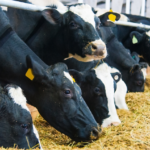
The Beef with Hormones – and 8 Other Foods You Might Find Them In
We recently answered a reader question asking why the United States is the only country to allow hormones in food animal production and the answer is, well, it’s not. But why is it banned in some countries and why is it used at all? We checked in with Dan Thomson, MS, PhD, DVM, Jones Professor of Production Medicine and Epidemiology at Kansas State University, for some answers. Dr. Thomson tells us that we would have to ask the countries that don’t allow it and he can’t find any science to say that we shouldn’t be using this technology.
Steroid hormones are used in beef cattle to improve feed efficiency and growth rates of cattle by 15-20 percent during the finishing phase – the last 150 days prior to the animal entering the food supply. Improved feed efficiency is important because it can help to reduce the carbon footprint of beef production. According to Dr. Thomson, “Beef cattle are treated with steroid implants. The steroids used are estrogen, progesterone and a testosterone analog called trenbolone acetate.” These are actually hormones that animals and humans naturally produce themselves. To his knowledge, Dr. Thomson says these products are not used in dairy and he is not aware of any other food animals that receive hormones.
How are they administered? Dr. Thomson tells us that “the steroid implants are subcutaneously administered in the middle one-third of the back of the calf’s ear. Cattle typically receive one or possibly two implants during a typical feeding period, which is 150-200 days. Steroid implants are approximately the size of an Advil tablet or 200 mg. So, we are treating 800-pound animals with one 200 mg tablet over 150 days.” According to Dr. Thomson, these products were actually first tried in chickens and pigs. The estrogen implants made the chickens extremely fat and had no effect on the pigs, as they did not improve swine growth rates or feed efficiency like they do in cattle.
So how much can you expect to find in a hamburger that you might eat? Let’s look at the amount of naturally occuring steroids in 8-ounce servings of some foods:
 Source: Loy, Dan. 2011. Iowa State University Extension
Source: Loy, Dan. 2011. Iowa State University Extension
All you meat lovers will be glad to hear Dr. Thomson say that steroid implants have no effect on beef quality, according to published research. More importantly, though, the meat is safe. The technology has been used since 1954 and there are strict guidelines and regulations in place to assure that neither human health nor animal health is negatively impacted. When compared to meat and milk that come from animals raised without hormones, the difference is…there is none. The USDA, the Academy of Nutrition and Dietetics and the Journal of Clinical Nutrition have all stated that beef from natural and organic programs is not safer, more nutritious, more wholesome or different in appearance compared to beef from animals that have received steroid implants. Aside from cooking the burgers at your next barbecue to the proper internal temperature, there’s no need for you to stress about the quality of regular beef and hormone-free beef!
“100% British Beef” by John Bunting is licensed under CC BY 2.0


























